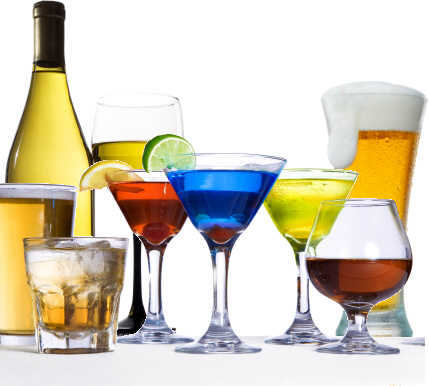Dr. Rachel Thompson, Science Programme Manager at the WCRF(World Cancer Research Fund) said not too long ago, “If you are drinking a pint of lager or a large glass of wine everyday, then this might not seem like a lot.” She further added, “But the science shows you are increasing your risk of bowel cancer by 18 percent and your risk of liver cancer by 20 percent.” 
In contrast here are the risks of lung cancer( just one of the many cancers that can arise) from smoking:
It was found that 172/1,000 of male current smokers will eventually develop lung cancer; the similar probability among female current smokers was 116/1,000. For those who never smoked on a regular basis the lifetime risk was substantially reduced. Only 13/1,000 males and 14/1,000 females in this category will develop lung cancer.
116/14= 8 or 172/13 = 13 times more likely, depending on gender. That's a lot more than the 20% added risk for liver cancer from a pint of beer!
Let's look closer. One drink is considered 12 fluid oz of beer or 5 fluid oz of wine, or 1.5 fluid oz of 80-proof distilled spirits. There are 28.3 grams in an ounce. At 5%, 12% and 40 % alcohol content, respectively, that corresponds to 17g of ethanol, regardless of type. From the data of a meta study, the pooled relative risk with a 95% confidence interval is only available for an average consumption of 25, 50 and 100g/day, which amounts to approximately 1.5, 3 and 6 drinks a day, respectively, with the latter being in alcoholic territory.
At the lowest end of consumption, the range of relative risk(RR) for all cancers is from 0.90 to 1.05, with an average of 1.01, which is not exactly alarming. But the overall average can lead to false security. For females drinking 25g /day,the risk of liver cancer doubles, and if they consume 100 g/day the risk jumps to 9 times, surpassing the lung cancer risk associated with cigarettesin women. Males experience much lower rates of alcohol-induced liver cancers: the RRs range from 1.28 to 1.62, depending on amounts ingested. For 25 g/d-drinkers of both sexes, there are elevated risks in the 1.4 to 1.7 zone for oral, larynx and esophageal cancers. Dr. Rachel Thompson was quoted as saying 1.18 for colon cancer; I see 1.14 in the data (assuming a pint of beer has 25 g; I calculate 23) . And the only other datum that stands out is the 1.31 for breast cancer which soars to an almost triple-risk for very heavy drinkers.
Statistics aside, how does ethanol induce cancers? No clear mechanism has been elucidated but there are many plausible scenarios, according to a 2006 review paper in the Lancet. Acetaldehyde, which is alcohol's main metabolite, is genotoxic, especially in genetically susceptible individuals where the acetaldehyde is not as quickly oxidized to the innocuous acetate. There is at least in vitro evidence that acetaldehyde and not alcohol itself does genetic damage in the liver, head, neck and breast. Ethanol also increases estrogen concentration, and it acts as a solvent for tobacco's carcinogens.
Sources:
Meta Study: http://pubs.niaaa.nih.gov/publications/arh25-4/263-270.htmReview Paper of Possible Mechanisms
http://www.omniameeting.com/filereviews/Cortese%20Review.pdf